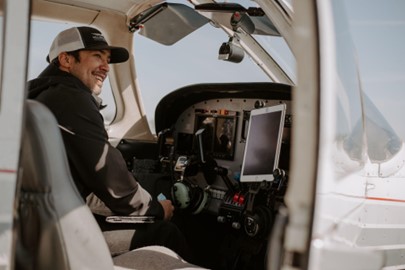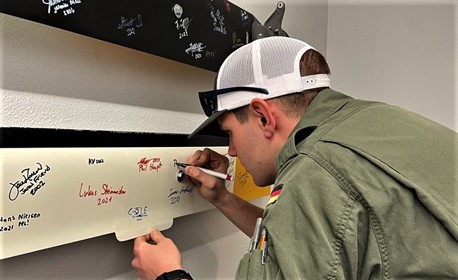Whether you’re excited or nervous about your first solo, there comes a time in flight training that requires sole occupancy of the aircraft for the very first time. Whether it takes 20 hours or 30 hours, your first solo flight will be a huge milestone for you and your Certified Flight Instructor. It isn’t until your CFI is left on the ground and you’re alone in the cockpit ready to take off all by yourself, that you realize all you’ve dreamed of was for this moment. But before you can get to this point, there are FAA requirements that must be met before you are able to go on your first solo flight.
.jpg?width=719&name=HHA_05_25_2022_LindseyTjaden%20(36%20of%2054).jpg)
What is a solo flight?
A solo flight is a big deal for aspiring pilots. This is the first moment you fly an aircraft by yourself with no CFI in the passenger seat telling you what to do next. You are the sole occupant of the aircraft, following your flight plan and in charge of the take-offs and landings. This is a very special moment for every student pilot as it is the very beginning of the rest of your career and something you will remember forever.
Airplane First Solo Procedures
The goal of a solo flight is to do your first flight alone! In addition to that, you will practice pre-landing and learning the traffic pattern as the sole pilot. At the beginning of your first solo, you will preflight, run up, and take off as usual with your Certified Flight Instructor. From there, you will do a few landings with your CFI beside you until they are confident that you are ready to go solo.
After your CFI gets out of the aircraft, your first solo begins. You will be the sole occupant in control of the aircraft to take off safely. Now remembering airspace and ATC, you’ll use this knowledge to safely communicate to ATC as you do closed traffic patterns. This pattern will take you on a continuous loop around the airport while you do low approaches or touch-and-goes for about 20 minutes. Your solo flight would be roughly 45 minutes including run-up, taxing, and take off.
Helicopter First Solo Procedures
Similarly, a first solo in a helicopter follows the same timeline. The first half of your first solo will be conducted with your instructor as they supervise you performing multiple maneuvers from normal and vertical take-off/landings to hovering, taxiing, and normal approaches.
Once your instructor deems they are confident you are ready to solo, you’ll leave them on the ground and begin the solo flight. You’ll practice the same maneuvers performed during the first portion of the flight and are limited to vertical takeoffs and landings, hovering, hover taxi, normal takeoffs, and normal approaches. Once you’ve demonstrated safe and good judgment with each maneuver as the sole occupant of the aircraft, you’ve completed your first solo.
How many flight hours is required to solo?
For airplane pilots, 30 flight hours are required prior to soloing per FAA standards under FAR Part 141. As you move through your private pilot course, you will learn certain terms and gain the necessary knowledge about the aircraft. For helicopter pilots, per FAA requirements, 20 hours are required in order to do the first solo flight. Just like with airplane training, the course is split between ground and flight courses that teach you practical knowledge in the ground lesson, then hands-on experience during the flight course that allows you to begin building your hours.
Practical Knowledge Before a Solo
A few topics that students will learn during the practical portion of their training leading up to their solo flight are:
- Situational awareness
- Airspace
- Airplane limitations
- Performance
- Understanding ATC phraseology
- Airport Diagram
Flight Lessons Before a Solo
Once you’ve completed the practical portion of your training, the next steps are gaining hours while implementing this knowledge into your flight training. These lessons cover the essentials and some only apply to airplane or helicopter training:
- Slow fly
- Stalls
- Steep turns
- Takes off and landing
- Reject of take offs and landing
- Pre-flight
- Stabilized approach applied
- Hovering
- Taxi
You can read more about what is covered in the airplane private pilot course here and the helicopter private pilot course here.

What is required for a solo flight?
Just like learning how to drive a car, there is basic information about an aircraft and how to control that aircraft which every student needs to know before attempting to go solo. During your private pilot course you will learn aircraft and pilot basics. For instance, you’ll learn the aircraft's systems and how to properly pre-flight to ensure the aircraft is safe and ready to go on a flight. You’ll also learn about weather and how to properly plan your flight based on the weather and aerodynamics. There will also be lessons covering FAA regulations and airspace to get you familiar with these regulations. After all, in order to drive a car on main roads, you’d need to know how to navigate around other cars.
Do you need your logbooks for a solo?
As you get ready for your first solo, a few documents you will need to have in hand that are essential to bring to your first flight would be your endorsement in your logbook, your student pilot certificate, FAA Medical certificate, and a photo ID. These documents are key to have in hand before getting to go solo for the first time. These documents are essential to have with you on any flight, so it is a good idea to get used to bringing them along from your very first flight. If you find it hard to remember which documents to bring at the start, just remember the term SMILE. Student pilot certificate, Medical, ID, Logbooks, Endorsements. Remember to bring your smile and a positive mindset as you prepare for your first solo.
Solo Traditions
Now that you’ve completed your solo, what should you do next? Celebrate! Your first solo was a huge milestone and a great accomplishment during your flight training. There are many different traditional ways across the globe that student pilots choose to celebrate their first ever solo. Here at Hillsboro Aero Academy, students choose to partake in a few different traditions to celebrate their solo.
Cutting of the shirt
After the first solo, the instructor will cut the back of a soloing student’s shirt to symbolize their confidence in their student. The piece of shirt is signed, dated as a reminder of this important flight to be kept as a souvenir.
Water Dunking
Drenching a pilot with water is an international tradition to congratulate and celebrate a successful first solo flight.
First Solo Wall
At our Hillsboro Campus, just west of Portland Oregon, our students have the opportunity to have their photo with their solo aircraft posted on the First Solo Wall just inside of the pilot lounge.
First Solo Rotor Blades
At our Troutdale Campus, located just at the edge of the Columbia River Gorge, students celebrate their first solo by signing their name on a displayed roto blade after they’ve completed their first solo fight.
HAA Wings
At our Redmond Campus in Central Oregon, our students receive their HAA Wings as a symbol of this big achievement during their professional pilot career.

Interested In Learning More?
If you’re interested in scheduling a demo flight and taking your professional pilot career off the ground, you are welcome to reach out to our admissions team at 503.726.3000 or info@flyhaa.com with any questions or for information to get you started.

